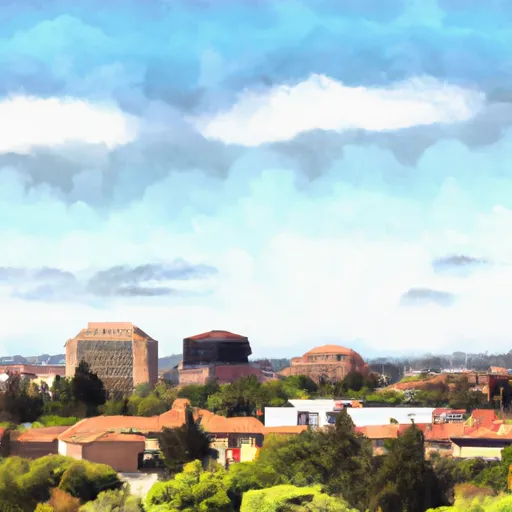-
 Snoflo Premium
Snoflo Premium
Get unlimited access to all our content
With no Ad interruptions! - Start Your Free Trial Login with existing account
Stanford
Eden Index
Climate
7.5
•
Recreation
5.4
•
Community
7.8
•
Safeguard
6.8/10

Located in the heart of Silicon Valley, Stanford, California is home to one of the world's most prestigious universities, Stanford University. The climate in Stanford is characterized as Mediterranean, with warm, dry summers and cool, wet winters. Summers are typically sunny with temperatures ranging from the mid-70s to mid-80s Fahrenheit, while winters are mild with temperatures averaging in the mid-50s.
Hydrologically, Stanford is situated in Santa Clara County, which is part of the San Francisco Bay Area. The county is fed by various groundwater basins and relies on imported water from the Sierra Nevada Mountains. The hydrology of the region plays a crucial role in supporting agriculture, industry, and residential water needs.
Stanford offers ample outdoor recreational opportunities. The university's campus itself boasts beautiful gardens, hiking trails, and vast open spaces. Nearby, visitors can explore the picturesque nature preserves of the Santa Cruz Mountains or enjoy water activities in the San Francisco Bay. Popular outdoor activities in the area include hiking, biking, birdwatching, beach visits, and various water sports like kayaking and paddleboarding. With its mild climate and abundant natural beauty, Stanford, California offers a wide range of outdoor activities for residents and visitors alike.
What is the Eden Index?
The Snoflo Eden Index serves as a comprehensive rating system for regions, evaluating their desirability through a holistic assessment of climate health, outdoor recreation opportunities, and natural disaster risk, acknowledging the profound impact of these factors on livability and well-being.
Climate Health Indicator (CHI): 7.5
Stanford receives approximately
415mm of rain per year,
with humidity levels near 87%
and air temperatures averaging around
15°C.
Stanford has a plant hardyness factor of
9, meaning
plants and agriculture in this region tend to thrive here all year round.
By considering the ideal temperature range, reliable water supplies, clean air, and stable seasonal rain or snowpacks, the Climate Health Indicator (CHI) underscores the significance of a healthy climate as the foundation for quality living.
A healthy climate is paramount for ensuring a high quality of life and livability in a region, fostering both physical well-being and environmental harmony. This can be characterized by ideal temperatures, reliable access to water supplies, clean air, and consistent seasonal rain or snowpacks.
Weather Forecast
Streamflow Conditions
San Francisco Bay
Area Rivers
San Francisco Bay
Snowpack Depths
San Francisco Bay
Reservoir Storage Capacity
San Francisco Bay
Groundwater Levels
Recreational Opportunity Index (ROI): 5.4
The Recreational Opportunity Index (ROI) recognizes the value of outdoor recreational options, such as parks, hiking trails, camping sites, and fishing spots, while acknowledging that climate plays a pivotal role in ensuring the comfort and consistency of these experiences.
Access to outdoor recreational opportunities, encompassing activities such as parks, hiking, camping, and fishing, is crucial for overall well-being, and the climate plays a pivotal role in enabling and enhancing these experiences, ensuring that individuals can engage in nature-based activities comfortably and consistently.
Camping Areas
| Campground | Campsites | Reservations | Toilets | Showers | Elevation |
|---|---|---|---|---|---|
| Portola Redwoods State Park | 53 | 504 ft | |||
| San Mateo Memorial County Park | 156 | 193 ft | |||
| Anthony Chabot Regional Park | None | 858 ft | |||
| Butano State Park | 39 | 181 ft | |||
| Henry Cowell Redwoods State Park | 113 | 658 ft | |||
| Big Basin Redwoods State Park | 102 | 1,005 ft | |||
| Sanborn - Skyline County Park | None | 1,278 ft |
Catastrophe Safeguard Index (CSI):
The Catastrophe Safeguard Index (CSI) recognizes that natural disaster risk, encompassing floods, fires, hurricanes, and tornadoes, can drastically affect safety and the overall appeal of an area.
The level of natural disaster risk in a region significantly affects safety and the overall livability, with climate change amplifying these risks by potentially increasing the frequency and intensity of events like floods, fires, hurricanes, and tornadoes, thereby posing substantial challenges to community resilience and well-being.
Community Resilience Indicator (CRI): 7.8
The Community Resilience Indicator (CRI) recognizes that education, healthcare, and socioeconomics are crucial to the well-being of a region. The CRI acknowledges the profound impact of these elements on residents' overall quality of life. By evaluating educational resources, healthcare accessibility, and economic inclusivity, the index captures the essential aspects that contribute to a thriving community, fostering resident satisfaction, equity, and social cohesion.

